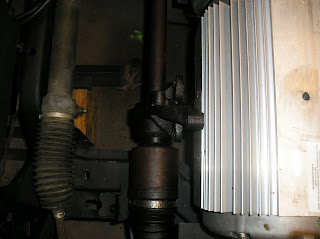So here's what I'm thinking.
Donor vehicleIn the converting world, there seem to be two schools of thought. Either go as light as you can (CRX, 914) or use a small truck (Ranger, S10) and load it up with batteries. Having seating for only 2 is fine with me, but I'm not enamored with the thought of driving a truck to work every day. Plus, why drag along 1800 lbs of Pb just to get me to and from work? I'm already used to driving an econobox ('97 Civic), so my plan is to convert a light, small car.
I'd convert my Civic (not quite as light as a CRX, but close) except that it's a sedan and my assumption is that in converting a small car I'll need to remove the back seat to make room for batteries. It just seems weird to me to have 4 doors and only 2 seats. Anyway, I'll need to commute to work in
something while I'm converting, so my current car will not be the donor. It's a shame, too, because I think my Civic is on its last legs.
Donor car requirements:
- Coupe or hatchback.
- Readily available and cheap parts. (so, no CRX or 914)
- Air bags. (at least for the driver)
- Body in excellent shape, minimal chassis rust.
- ABS. (nice to have)
- Curb weight under 2,500 lbs.
- Under $1,000 price.
After some research (
Craig's List,
eBay,
InternetAutoGuide, etc.) I came to the conclusion that my choices are extremely limited. As a matter of fact, I quickly narrowed my search to one vehicle. A Saturn SC1/SC2 from '95-'02 (the airbag years). A lightweight, plentiful, airbagged coupe available with ABS. Not only that, I decided there was a certain symmetry (or poetic justice) to converting a car from the same company that had a viable electric vehicle and decided to crush it.
AC/DCSo, what to put in this donor car? Most conversions use series-wound DC motors. They are simpler, cheaper, and have better low-end torque. However, they are also limited to low voltage, lack regenerative braking, are less efficient, and have limited RPM range. For me, the killer is the low voltage limitation. Low voltage means high current from the batteries, high enough that the only usable batteries are flooded Pb-Acid. By contrast, AC induction motors are more complex and expensive, but can use high-voltage battery packs, provide regenerative braking, are more efficient, have flatter torque curves, and can spin to ludicrous RPMs.
Since I've already decided that the electric components will outlast any donor vehicle (maybe 2 or 3 donors!) my assumption is that whatever system I use would last long enough to where I'd be able to take advantage of low-cost, durable lithium batteries that I believe will be available (eternal optimist that I am). The only way to take advantage of those next-generation batteries is to use AC. At this time, however, the best value in batteries are still flooded Pb-Acid so I'll start my EV life with those.
Will it work?Requirements for the car:
- Capable of highway speeds (though highway speeds kill the range)
- Acceleration which is not embarassing (to a guy who drives a Civic)
- Sufficient range to get me to work (15 miles @40 mph with less than 20% DOD
- Cabin heat (New England weather)
There are a bunch of EV calculators on the web (
Uve's,
EVConvert, etc.), but they don't have information on AC motors/controllers. So I did a bit of my own modeling. I think it's good (my model matches the web calculators when I use DC motor parameters) but I must admit I don't know enough about how motors work to know for sure. But anyway, I think my component choice will give me the performance I need to make a viable commuter car.
My plan:
- 156 V battery pack (12V flooded Pb-Acid batteries)
- AC24 or AC24LS AC induction motor with DMOC445 controller
- 220V on-board charger
- Electric water heater for cabin heat
- Power brakes (electric vacuum pump)
- Manual steering, no A/C
My model predicts top speed of over 70 mph (though it might take the entire battery capacity to get there), 50+ mile range at 40 mph, and a battery lifetime of >4 years. Ok!
BudgetHard to believe how much I'm going to be spending. There are cheaper ways to go (even sticking with AC), but I want to maximize my chances of success here so I'll rely on the experts at
ElectroAuto and purchase one of their kits. Most likely the AC24 motor, but I may splurge for the extra torque of the AC24LS. So... gulp... $10K for a kit, another $2-3K for batteries, $1K for the donor, and probably another $500 in miscellany. I just have to keep in mind that it's cheaper than buying a new car, or even a late-model used one. And these components should last a lot longer.
So let's find a car!
















































